Snake Well Project
Base Metals
Kalamazoo announced on 14 November 2018 that it had sold its Snake Well Gold Project in the Murchison region of Western Australia for AUD$7m to Adaman Resources Pty Ltd. The sale price represents $50 per resource ounce. A key part of the transaction is the retention by Kalamazoo of a 2.5% Net Smelter Royalty on any base metals mined within the project area. Full details of the transaction can be found in the Company’s ASX announcements dated 14 November 2018 and 27 December 2018.
The Snake Well Base Metals Project is located 170km northeast of Geraldton and 450km north of Perth in WA’s south Murchison Region. It consists of five granted mining leases, one granted exploration licence and two exploration licence applications. The Snake Well tenement holding covers an area of 263km² over prospective Archaean rocks of the Tallering Greenstone Belt and extends for a strike length of ~45km. The Project is located in the western portion of the Murchison Domain which hosts a number of significant mineral deposits including EMR Capital’s Golden Grove (Cu-Zn), Big Bell (Au) and Cue (Au) deposits, Doray Minerals’ (ASX:DRM) Deflector (Cu-Au) and Ramelius Resources’ Mt Magnet (Au) Mines. The Project’s location and regional mineral deposits are shown in Figures 1 and 2.
Kalamazoo acquired the Snake Well Gold and Base Metals Project from Atlas Iron (ASX: AGO) in April 2013. After further exploration and drilling Kalamazoo undertook a successful trial mining operation producing 4,459 ounces of gold at 6.83g/ in 2016. The only other recorded gold production from within the Tallering Greenstone Belt is from the historic Royal Standard Gold Mine (in the northeast of the Project area) where 68,000t at 13.1g/t Au was mined between 1897 and 1937 (Cranley, N.J., 1985).
Gold was first detected at Rabbit Well (within the Snake Well Project) late in the 1980s by Polaris Pacific NL (Polaris) who defined a surface gold-in-pisolite anomaly extending over approximately three kilometres. Conzinc Riotinto Australia Ltd (CRA) followed up with additional broad spaced surface sampling and drilling between 1992 and 1994, discovering both bedrock lode and laterite mineralisation.
Roebuck Resources NL (Roebuck) subsequently conducted numerous phases of drilling between 1997 and 2002 and outlined a number of number of gold and base metal prospects, largely through surface geochemical exploration. Subsequent shallow RAB and RC drilling delineated a number of gold deposits including the Mixy and A-Zone (the latter with elevated copper, lead, zinc and silver levels).
Figure 1. Location Map of Snake Well Base Metals Project
Figure 2. Location of the Snake Well Base Metals Project
Project Geology
The Tallering Greenstone Belt trends east-northeast and is bounded by granite-gneiss terrane. The layered sequence includes variably foliated and metamorphosed mafic volcanic and intrusive rocks, felsic volcanic rocks as well as clastic and chemical sedimentary rocks. Post-tectonic granitic rocks have intruded the central eastern part of the Belt and the entire area is cross cut by numerous Proterozoic mafic dykes.
Snake Well covers a portion of the Southern Shear Zone at the southern margin of the Belt, with an Archaean sequence dominated by mafic, felsic and pelitic schists (Figure 3).
The succession of felsic and pelitic schists (interpreted as being formerly fine to medium grained volcanogenic and clastic rocks) that lie to the north of, and parallel to the Rabbit Well mafic schists, are host to the A-Zone gold resource and Conquistador prospect, both of which may have affiliations with original volcanic hosted style gold-base metal mineralisation (VHMS).
Figure 3. Snake Well Project local geology and prospect locations and mineral resources
Snake Well Base Metals
Prior to the sale of the Snake Well Gold Project, Kalamazoo reviewed the base metal potential (Figures 4 and 5) especially in the transition and fresh (sulphide) zones and also at the nearby VHMS* Base Metal Prospect “Conquistador” (Figure 3).
The occurence of significant base metals at A-Zone, particularly in the transition and fresh rock has the potential to value-add to the project.
As part of the metallurgical sampling for the oxide portion of the A-Zone in 2017, various base metals were also sampled. The levels of copper, zinc, lead and silver gave rise to an additional assay program to gauge the levels of base metals in the A-Zone oxide and primary (sulphide) zones.
Re-assay program in oxide, transition and fresh rock zones indicated very significant levels of copper, lead, zinc and silver.
With base metal assays of up to 5.76% Copper, up to 7.07% Zinc, 1.88% Lead and up to 247 g/t Silver. Refer to ASX: KZR 23 June 23 2017.
Results received for the re-assayed pulps include:
- 15 metres of 2.85 g/t Au, 0.25% Cu, 0.33% Pb, 1.23% Zn and 17.7 g/t Ag from 59 metres in hole MJAZRC010;
- including; 2 metres of 8.68g/t Au, 0.66% Cu, 0.70% Pb, 4.12% Zn and 45.5 g/t Ag from 59 metres
- 9 metres of 4.35g/t Au, 0.61% Cu, 0.22% Pb, 0.09% Zn and 26.2 g/t Ag from 40 metres in hole MJAZRC009;
- including; 1 metre of 6.67 g/t Au, 2.57% Cu, 0.30% Pb, 0.07% Zn and 153 g/t Ag, from 45 metres
- 1.1 metres of 0.44 g/t Au, 5.76% Cu, 0.18% Pb, 0.20%Zn and 48.5 g/tAg from 47.7 metres in hole MJAZDD001; and
- 1 metre of 6.19 g/t Au, 0.20% Cu, 0.66% Pb, 7.07% Zn and 16.6 g/t Ag from 57 metres in hole MJAZRC024;
Base metal zones are spatially associated with the gold mineralised lodes and may form a halo of a few metres around the gold lodes.
Kalamazoo is very encouraged by these results and the potential VHMS* association and is a key reason why it has retained a 2.5% Net Smelter Royalty on any base metals mined by third parties from the project area into the future.
* Volcanic Hosted Massive Sulphide Deposits and these represent a significant source of the world’s copper, zinc, lead, gold and silver ores.
Figure 4. A-Zone Drill collar and section location plan, base metal resampling
Figure 5. A-Zone Cross Section A-B looking southwest with gold resource outline
(Intersections are down hole lengths of >0.5 g/t Au, and include a maximum of 2m at <0.5 g/t Au
Note: Selective historical drill hole intercepts were included within the Mineral Resource for A-Zone)





